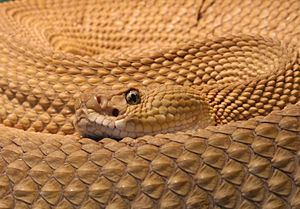Viper facts for kids
Quick facts for kids Vipers |
|
|---|---|
 |
|
| Mexican west coast rattlesnake, Crotalus basiliscus |
|
| Scientific classification | |
| Kingdom: | |
| Subphylum: | |
| Class: | |
| Order: | |
| Suborder: | |
| Family: |
Viperidae
Oppel, 1811
|
Vipers are a group of venomous snakes known as the Viperidae family. All vipers have special long, hinged fangs. These fangs can fold back when the snake's mouth is closed. When a viper bites, its fangs swing forward and inject venom deep into its prey. This venom can cause internal bleeding in the bitten animal. There are four main types, or subfamilies, of vipers found around the world.
Contents
What Are Vipers Like?
All vipers have a pair of long, hollow fangs. These fangs are like tiny needles that deliver venom. The venom is made in special glands located at the back of their upper jaws. This venom is a powerful liquid that helps the snake catch its food.
Most vipers have rough, ridged scales. They usually have strong bodies with short tails. To make space for their venom glands, their heads are often shaped like a triangle. Vipers have slit-shaped pupils in their eyes. These pupils can open very wide in the dark or close almost completely in bright light. This helps them see well in different light conditions. Vipers are also nocturnal animals. This means they are active and hunt at night, and they rest during the day.
What Do Vipers Eat?
Vipers are predators, which means they hunt and eat other animals. Their main diet includes birds, and sometimes even bird eggs. They also eat amphibians like frogs and toads. Smaller reptiles, such as lizards and other snakes, are also part of their diet.
Viper Reproduction
Most viper species are ovoviviparous. This means they give birth to live young, rather than laying eggs. The baby vipers develop inside the mother's body until they are ready to be born. A few types of vipers do lay eggs, but this is less common. The name "viper" comes from Latin words meaning "I live" and "I give birth."
Where Do Vipers Live?
Viper snakes can be found in many parts of the world. They live in the Americas, Africa, and across Europe and Asia (Eurasia). In the Americas, they are found from southern Canada, through the United States, Mexico, and Central America, all the way down to South America. In the United Kingdom, the only type of viper that lives there is the adder.
Types of Vipers
There are four main groups, or subfamilies, of vipers. Each group lives in different parts of the world and has unique features.
- Azemiopinae (Fea's viper): This group has only one species. It lives in parts of Myanmar, Tibet, China, and northern Vietnam.
- Causinae (Night adders): This group has six species. They are found in Subsaharan Africa.
- Crotalinae (Pit vipers): This is a large group with many species. They live in the Old World (Europe, Asia, including Japan and India) and the New World (from Canada down to South America).
- Viperinae (True vipers or pitless vipers): This group has many species. They are found in Europe, Asia, and Africa.
Images for kids
-
A rattlesnake skull, showing the long fangs used to inject venom.
-
The western diamondback rattlesnake Crotalus atrox. Its venom helps the snake track down prey it has bitten.
See also
 In Spanish: Vipéridos para niños
In Spanish: Vipéridos para niños




